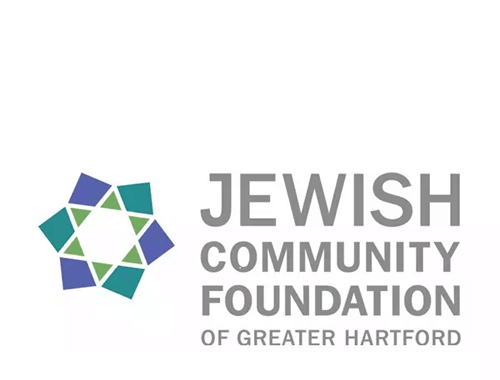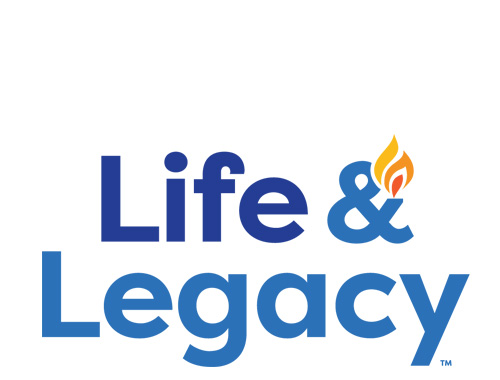Schechter Shavua: December 16, 2022
Schechter Re-Dedicates Holocaust Memorial with Moving Ceremony
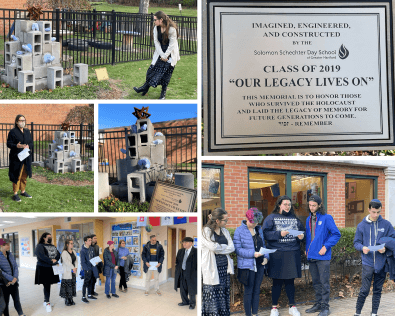 On a blustery morning in late November, a group gathered at Schechter to re-dedicate the school’s Holocaust Memorial. Members of Schechter’s Class of 2019, who had designed and built this special sculpture when they were in seventh grade, unveiled a new plaque. Along with their parents, and Schechter staff who attended, they also had the privilege of hearing a moving talk from Holocaust survivor Rabbi Phillip Lazowski.
On a blustery morning in late November, a group gathered at Schechter to re-dedicate the school’s Holocaust Memorial. Members of Schechter’s Class of 2019, who had designed and built this special sculpture when they were in seventh grade, unveiled a new plaque. Along with their parents, and Schechter staff who attended, they also had the privilege of hearing a moving talk from Holocaust survivor Rabbi Phillip Lazowski.
Rabbi Lazowski, who was eleven when he fled during the Holocaust and eventually joined the resistance against the Nazis, addressed the now twelth-grade students who created the monument five years ago. He reminded them of the importance of hearing survivors’ stories, because “in five or six years, there will be no more living survivors of the Holocaust.” He urged all of the attendees to speak out against injustice, prejudice, and anti-Semitism. Representatives from Voices of Hope, a non-profit organization in Connecticut providing education about the inhumanity of the Holocaust and other genocides, also offered remarks.
The project began in 2018, when Schechter collaborated with the organization Facing History and Ourselves to design and later construct the large stone structure. Its core is a tower of cement blocks, which represent the hardship of the Holocaust: a rough and difficult material, something hard as stone. Blossoming from the blocks are open hands, shaped from a much smoother and softer-looking cement. These represent the new generations of Jews who survived and flourished after the Holocaust. Students made molds for the hands using their own hands as well as those of two grandparents who were Holocaust survivors. In some cases, a student molded his/her hand while clasped with their grandparent who survived the Holocaust. The six bricks around the memorial represent the six death camps as well as the six million Jews lost in the Holocaust.
In the spring and summer, a variety of flowers native to Israel and Europe bloom from the cracks in the cement and around the monument. Daffodils return each spring, symbolizing hope, rebirth, memory, awareness, reflection, and forgiveness. The contrast of the hopeful and joyous colorful flowers against the stark and somber stone structure captures the themes of death and new life.
Back in 2019, seventh grader Alyssa Temkin noted, "The most impactful piece of this [sculpture] is where my Poppy and I have our hands clenched together. His courage and strength is forever intertwined with me. We represent the beauty that came after devastation, we will continue to grow, flourish and remember. The Holocaust is a legacy that I want to carry on from my grandfather and bring onto future generations so we will never forget."
Students Find Inspiration in Jewish Art
In art class, Anafim students (grades 1-2) have been studying Jewish art. First they learned about Chagall and made their own Chagall-inspired pastel drawings of villages. Next, they learned about Jewish decorative arts and drew some original designs for mezuzot. They selected one of their designs and created a clay version, which was then baked until it hardened. Students will be able to place a scroll inside and hang it on a doorpost!
Click HERE to see photos of Anafim’s beautiful Jewish art.
Play Ball! Learning Spanish through the World Cup
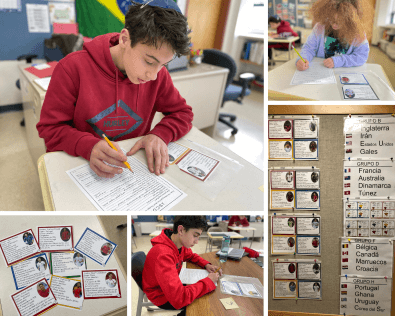 In Middle School, Spanish students are enthusiastically participating in a World Cup mini unit. Señora Castro is helping them keep track of the tournament using a bracket showing the progression from the group stage to quarter finals, semi finals and finals. All students learned how to express the Spanish names of the 32 countries participating in the World Cup and listened to its official multilingual songs. Spanish 3 students presented information about players from each of the 32 countries and employed many soccer terms. They used their reading comprehension skills to describe the history of the World Cup and played a game in which they gathered information to answer questions about some of the key players. Señora Castro is a huge fan of Brazil’s soccer team and views the World Cup as a wonderful opportunity to showcase a passion for "the beautiful game" that unites much of the world.
In Middle School, Spanish students are enthusiastically participating in a World Cup mini unit. Señora Castro is helping them keep track of the tournament using a bracket showing the progression from the group stage to quarter finals, semi finals and finals. All students learned how to express the Spanish names of the 32 countries participating in the World Cup and listened to its official multilingual songs. Spanish 3 students presented information about players from each of the 32 countries and employed many soccer terms. They used their reading comprehension skills to describe the history of the World Cup and played a game in which they gathered information to answer questions about some of the key players. Señora Castro is a huge fan of Brazil’s soccer team and views the World Cup as a wonderful opportunity to showcase a passion for "the beautiful game" that unites much of the world.
Mazal tov to 2022-2023 Student Council Members
Mazal tov to this year’s student council representatives! They are holding regular meetings to plan holiday programming for the middle school, community service/fundraising projects, and other inspirational ideas. Stay tuned to hear more about their projects throughout the year!
President- David M.
Vice President- Noah C.
Treasurer- Noam B.
Secretary- Nava E.
6th Grade Rep- Nathaniel A.
5th grade Reps: Cordelia R., Reva C.
Vayeshev and (almost) Hanukkah— Concealing and Revealing
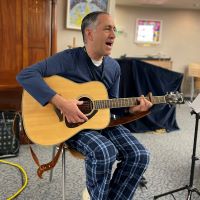 We are gearing up for H anukkah, we are gearing up for winter vacation — and we are about to read Parashat Vayeshev, which begins the story of Joseph. Is there a thread that connects each of these upcoming events?
We are gearing up for H anukkah, we are gearing up for winter vacation — and we are about to read Parashat Vayeshev, which begins the story of Joseph. Is there a thread that connects each of these upcoming events?
The essence of H anukkah is to openly celebrate and express gratitude. Most of Judaism’s holiday practices take place in our homes or synagogues; only people in our household or congregation see them. And while we are allowed to build our sukkah in front of our house, we don’t have to; they can go in courtyards or backyards where no one can see them. But h anukkiyot are supposed to be lit so that passers-by can notice them; the explicit purpose is pirsumei nisa , “publicizing the miracle.” And while the Talmud does say that in times of persecution, you can hide your hanukkiyah, this is a last resort. The holiday’s real goal is to celebrate our ability to live openly as Jews.
The story of Joseph is ultimately about a similar theme. The climax of the story comes when Joseph, who had disguised his identity from his brothers, finally reveals himself. The other lead character, Judah, transforms from a jealous bully to a courageous hero by publicly confessing a hidden sin. Over the course of the narrative, we move from concealment to openness. These themes connect this week’s parashahand next week’s holiday.
And what of winter break? Thankfully, our lives are less dramatic than those of the Maccabees or of Joseph and his brothers. But we live in a time when hateful expressions of anti-Semitism are more common then they’ve been in decades, when many of us might be tempted to conceal our Judaism, or confine it to our homes and synagogues. Perhaps this year, over winter break, we might instead find ways to openly, proudly, joyfully celebrate our Jewish identities in ways that capture both the Hanukkah spirit, and Joseph’s embrace of his true identity.
May we enjoy peaceful Shabbat, a joyous Hanukkah, and a fun vacation!
Shabbat shalom,
Rabbi Jonathan Berger
Head of School
Questions for the Shabbat table:
1. How do you think Joseph felt when revealing himself to his brothers?
2. Have you ever revealed something about yourself after keeping it secret? Was it hard or easy? How did it feel?
Solomon Schechter Day School
of Greater Hartford
26 Buena Vista Road
West Hartford, CT 06107
© Solomon Schechter Day School of Greater Hartford | Site design Knowles Kreative

